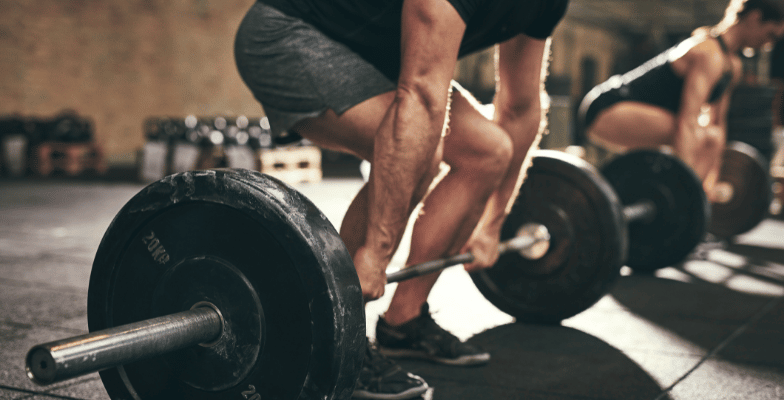Compound Exercise Vs. Isolation Exercise: Which Is Better?

Introduction
When a newbie joins a gyms and eyes a guy with 18-inch biceps doing concentration curls and cable crossovers, both isolation movements to train his chest, he starts to feel that the secret to building a muscular physique and an 18-inch arm is to perform isolation exercises!
Hmmm….
What he fails to imagine is that that muscular guy with an 18-inch bicep has spent thousands of hours in the gym for many years doing compound lifts, building up his size and, therefore, his physique.
What he is now doing is simply refining and perfecting his physique. So first, let’s try and understand what exactly we mean by compound and isolation exercises and then see which one is better or not!
Compound Exercise
Any exercise that involves multiple joints and muscle groups can be termed a compound movement.
For example, when doing a squat, the ankle joint, knee joint and hip joint are all involved in doing the movement. Multiple muscle groups like the quadriceps complex, hamstring complex, hip musculature and the entire core musculature are involved.
So besides squats, some more common examples are deadlifts, military presses, chest presses, incline presses, lat pulldowns etc.
All these above exercises have a prime mover i.e., the main muscle group doing most of the work and secondary muscles support the prime moves in completing the required movement.
6 Benefits Of Compound Exercise
1) Mimics Real-Life Movement And Builds Functional Strength
My boy, who is now 4 years old, squats (natural free squat and not barbell squat…hehe…) all the time.
It’s a completely natural movement that mimics real-life movement. In fact, when visiting my village in Haryana, India a few times a year, I notice that the villagers there sit in a low squat position most of the time.
My dad calls this position “Ukudu,” meaning a low squat. When females clean the house with a broom, they do this low squat as well.
The same thing with deadlifts, even so, more with a trap bar. It’s like squatting down and lifting an object. When your workouts comprise these functional movements, you build real-life functional strength that otherwise is not possible with isolation exercises which we shall discuss in just a while.
2) Helps You Build Muscles Faster
Studies have shown that compound movements help release a lot of testosterone and human growth hormone, which are key hormones when it comes to building muscles.
3) Helps You Burn More Fat And Also Provides Significant Cardiovascular Benefits
Squats involve almost 200 muscles, that pretty much your entire body. A rep of a compound lift is metabolically much more challenging than a rep of a bicep curl, as more muscles are recruited to perform the action.
The EPOC effect when doing compound lifts is much higher than when your workouts comprise of isolation exercises. This not only gives your heart a good workout but also burns more calories even after you have done your workout (EPOC-Exercise post-oxygen consumption).
4) Works Your Stabilizing Muscles To The T
You might want to read my post on free weights vs. machines to understand this point better:
Related Article: Free Weights Or Machines: Which Is better?
5) Helps Save A Lot Of Time
Just three movements, squats or trap bar deadlifts, incline dumbbells press, and pull-ups, can pretty much cover your entire body.
People who are short on time can easily perform 3-5 main compound movements a few times a week to train their entire body and also get good results. The total time commitment, in this case, won’t exceed 90-120 minutes!
6) Helps You Build A Fabulous Body
Ok, I know you don’t want to look like a bodybuilder (no pun intended). Bodybuilders have this different look, puffy muscles, and a unique look. In fact, they walk differently; this is because of their focus on isolation exercises and working out only in one plane of motion -the Sagittal Plane. Muscles don’t work that way.
They work in three planes of motion and always as a unit. Too many isolation lifts disrupt the natural firing and motor recruiting sequencing, causing a person to look and walk differently than a person who focuses on functional and compound movement.
With so many amazing benefits of compound exercises, do isolation exercises have any place in a workout routine?
Let’s find out.
Isolation Exercise
Any exercise that involves a single joint and only one muscle group (with no or very little help from other muscle groups) can be termed an isolation movement.
Some more common examples of isolation exercises are calve raises, bicep dumbbells curls, triceps pushdown, leg extensions, leg curls, etc.
Any benefits of isolation exercises?
Yes!
Isolation exercises help you bring up a lagging body part.
Need a 3-D look on your shoulders? Add a few sets of lateral and posterior raises to train your medial and posterior heads, respectively.
What about your calves?
Absolutely!
They don’t get enough stimulation when doing squats or trap bar deadlifts, and since they are a stubborn muscle (comprising mostly of slow twitch muscle fibers), you need to work them out with many sets a week if you need to see them grow.
Related Articles:
How To Squat: The Definitive Guide
Trap Bar Deadlift: The Definitive Guide
Although your biceps get a good pounding when you do back compound movement, so does triceps when you do heavy overhead presses and bench presses.
And in fact, in beginners’ workouts, I don’t recommend too much isolation arms movement, but as your progress and have gone past your beginner’s gains, you need to add a few sets each for the biceps and triceps and train them every 4/5th day if you want to see them grow.
And lastly, who does not want a nice, good-looking mid-section with abs popping out?
Compound movement gives your core area (abs included) a damn good workout but won’t make your abs blocky. Therefore, in order to flaunt an impressive midsection, you need to train your abs with weights using a couple of isolation exercises a few times a week!
Conclusion
The final verdict is that no exercises are superior to one or the another.
Both compound and isolation exercises have their place in one’s workout. However, do note compound exercise should always be a priority and should comprise at least 70-90% of your total workouts and should be performed before isolation exercises for any given muscle group.
What do you think about this article? Have any doubts or questions?
Let me know in the comments below!
Related Course:

Skill-Based Education.
Global Recognition.
Powerful Community Building
Secure a certificate of completion in as little as a day by graduating from one of our free courses.
Get Access to Our Free Courses. No Credit Card Required.

Fabulous Body Membership
Your All-Access Pass to A Fabulous Body & A Rewarding Career
25+ Certificate Courses & Programs, All Included
15 Day Free Trial, 100% Money-Back Guarantee
About Akash Sehrawat
Akash is a creator of 25+ programs and certificate courses in which more than 200,000 students have enrolled both on Udemy and Fabulous Body's native platform. Akash is also an author of three books that can be found on Amazon. His answers on Quora have gathered more than 12 million views in less than a year.











